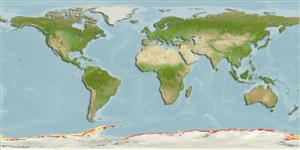>
Perciformes/Notothenioidei (Icefishes) >
Bathydraconidae (Antarctic dragonfishes) > Bathydraconinae
Etymology: Prionodraco: Greek, prion, -onos = saw + Greek, drako = dragon (Ref. 45335).
Eponymy: Admiral Edward Ratcliffe Garth Russell Evans RN CB, 1st Baron Mountevans (1880– 1957), known as ‘Teddy’ Evans was a Royal Navy Officer and Antarctic explorer. [...] (Ref. 128868), visit book page.
More on author: Regan.
Environment: milieu / climate zone / distribuzione batimetrica / distribution range
Ecologia
marino demersale; distribuzione batimetrica 70 - 550 m. Polar; 60°S - 78°S
Southern Ocean: South Orkney and South Shetland Islands, tip of Antarctic Peninsula north of 65°S and the Antarctic continental shelf.
Length at first maturity / Size / Peso / Age
Maturità: Lm 10.0 range ? - ? cm
Max length : 15.5 cm TL maschio/sesso non determinato; (Ref. 124149); 15.3 cm TL (female); peso massimo pubblicato: 17.00 g (Ref. 124149); peso massimo pubblicato: 17.00 g
Adults spawn apparently during autumn and early winter. Hatching probably occurs in spring and size at hatching at about 12 mm TL. Main food items are polychaetes and benthic crustacean (Ref. 5192). Larval pelagic phase is short (Ref. 41551).
Gon, O., 1990. Bathydraconidae. p. 364-380. In O. Gon and P.C. Heemstra (eds.) Fishes of the Southern Ocean. J.L.B. Smith Institute of Ichthyology, Grahamstown, South Africa. 462 p. (Ref. 5192)
IUCN Red List Status (Ref. 130435: Version 2025-1)
Threat to humans
Harmless
Human uses
Pesca: di nessun interesse
Strumenti
Special reports
Download XML
Fonti Internet
Estimates based on models
Preferred temperature (Fonte Biblio.
123201): -1.8 - 0.9, mean -1 °C (based on 273 cells).
Phylogenetic diversity index (Fonte Biblio.
82804): PD
50 = 1.0000 [Uniqueness, from 0.5 = low to 2.0 = high].
Bayesian length-weight: a=0.00263 (0.00171 - 0.00403), b=3.14 (3.01 - 3.27), in cm total length, based on LWR estimates for this species & (Sub)family-body (Ref.
93245).
Trophic level (Fonte Biblio.
69278): 3.3 ±0.3 se; based on diet studies.
Resilienza (Fonte Biblio.
120179): Medio, tempo minimo di raddoppiamento della popolazione 1.4 - 4.4 anni (Assuming Fec < 10,000).
Fishing Vulnerability (Ref.
59153): Low vulnerability (10 of 100).
🛈
